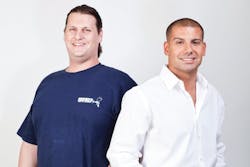Maybe it’s the timing of the question, coming just a week after his father passed away; or maybe it’s that his life’s frantic pace hasn’t slowed enough to allow much time for self-reflection. Whatever the reason, Joey O’Neill takes a long pause before trying to come up with an answer.
“What have the last three years been like?” He repeats, before letting out a deep sigh. “A whirlwind. That’s for sure.”
The highs and lows of ownership have come fast and furious to O’Neill, the 26-year-old owner of Benner’s Auto Body in Cranford, N.J. Thieving employees, scheming managers, illness, death, staff turnover, facility upgrades, full-on system changes—a lot can happen in just three short years.
“But, at some point,” he says, “you have to pull it all together; you need to take what you’ve learned, take what’s happened to you, and start making changes that help you move forward.”
And with the help of his childhood friend John Callandrello, 25, the two have done just that, turning a period of uncertainty into one of the most successful stretches in the company’s 103-year history. Every obstacle has led to a positive change. Sales have risen by more than $800,000 since 2010 (a 22 percent increase), cycle times have been slashed, and the company is now moving forward with systems, processes and an overall approach to business that will help Benner’s sustain this momentum.
Fool Me Twice …
The Problem: Before his father was diagnosed with lung cancer in late 2009, O’Neill worked as a shop manager, overseeing the smaller of the business’s two buildings. He’d grown up around the shop (his dad bought the business from the Benner family in 1980), but was still learning the ropes as a day-to-day worker.
During this “learning” period, O’Neill noticed the shop’s “parts ordering was a little screwy,” he says. “We were ordering all these parts, and I wasn’t seeing them show up in repairs.”
It turns out the employees were stealing. He fired all four of them on the spot, chalking it up to “some bad seeds.”
A month later, his father stepped away from the business, and, as the new owner, O’Neill began training with Sherwin-Williams as part of their A-Plus Vision Groups.
“It really gave me a good structure of what today’s market is really like and how we could move forward out of some old-school ways of doing things,” he says.
That led to a new focus on his financial numbers, and in September of 2010, another red flag came up: He realized the shop’s longtime controller was misappropriating funds.
After contacting authorities, they were able to prove that this longtime employee had taken out more than $600,000 over a five-year period.
The Lesson: This was a breaking point for him: “My parents started to wonder if a 23-year-old could handle this and fix everything that was going on.”
It was now blatantly obvious to O’Neill: The stealing wasn’t the result of a few bad employees (the controller was a well-trusted 13-year staffer). It was a lack of institutional control. It was his fault as the new owner.
“We didn’t have checks and balances,” he says. “There was nothing to prevent it from happening again.”
The Changes: O’Neill knew he wasn’t best suited to be analyzing the financial statements of a company that did $3.6 million in sales in 2010. That’s when he called Callandrello, who, fresh out of business school, was hired as his new controller in January of 2011.
“We’ve been best friends since freshman year [of high school],” Callandrello says. “We decided that Joey would be the guy who took care of the shop aspects, and I was the guy who tried to take the numbers and figure out how we could be more profitable.”
Callandrello was shocked with the way things were run at Benner’s. There was no true, streamlined management system, no thorough parts tracking system, and none of the financial information was accurately separated.
The first thing he did was help O’Neill figure out a better, computerized management system. (They went with Summit Software Solutions to run as an in-between with QuickBooks and CCC One.)
The change spurred quick financial organization, and gave Callandrello access to necessary information. He was able to process costing data in Summit, and then move the information to the correct financial areas in QuickBooks.
Essentially, this created a “double-entry accounting system,” Callandrello says, ensuring that all the numbers were regularly checked and ran through him.
Also, employees were no longer allowed to order their own parts unless they had management’s approval. And because of Callandrello’s new accounting practices, every order would eventually come through his desk for review.
O’Neill also worked to clean out the two buildings, removing any opportunity for stolen parts to be hidden.
“That was a big process—identifying those flaws and correcting them,” O’Neill says. “I think processes help your business operate ethically and morally. That’s what we were trying to do.”
Throwing Away Money
The Problem: The more he looked at the numbers, the more Callandrello thought the shop was underperforming.
“I mean, this was a successful business, and it had been for years—decades even—but the way we were tracking numbers and looking at things, you could see where there were huge opportunities for growth,” he says.
A lot of the issues were cost-related.
For instance, technicians were paid on a flat-rate system. That’s pretty standard, but the shop had always allowed them to select the hours they would receive in a pay period for in-process work.
“It wasn’t an honesty issue,” O’Neill says, “but if they got in a 20-hour job on Thursday when we were doing payroll, and hadn’t even started it, they would divide up maybe 10 of those hours for that pay check. They’d still finish the work, and were paid only for the work they did, but they were getting paid before they were finished.”
Paying techs for uncompleted work left a void in the company’s bank account and made accounting fairly confusing.
The Lesson: It came down to processes and systems, O’Neill says. Employees needed a clear formula for getting work done in an efficient way, and how to report that work.
He’d been introduced to lean processes during his training and his time spent observing other shops. He knew that, by putting in standard operating procedures (SOPs) and rearranging his shop floor, he could open up the business to a more efficient and profitable repair process that would eliminate those cost issues.
The Changes: With the help of his entire staff and a number of trainers, O’Neill created SOPs for every aspect of production—from blueprinting to teardown to paint cycles.
But he didn’t simply write down what the shop was already doing. He made drastic changes to the shop. He knocked down walls and compartmentalized everything, creating stations for specific aspects of the repair process. He also eliminated the parts department of the shop, replacing it with 30 parts carts that could move around the stations.
At the same time, he switched the shop to waterborne paint and sent his staff to training—shop employees went to skills and processes training, and his managers went to estimating training.
The final result was a lean-oriented shop with a cycle time average of 6.9 days and touch time of 4.9 hours per day. And with the newfound approach to repairing vehicles, everything was meticulously tracked. At pay time, technicians were only paid for the work they’d already completed, which included portions of in-progress jobs.
Drastic Turnover
The Problem: Some people simply don’t like change, O’Neill says. He understands that, and he was expecting some blowback from staff.
In reconfiguring his shop’s operations in 2011, roughly 40 percent of Benner’s 20 employees either quit or were fired for not complying with the changes.
“That was pretty hard, and it was a little scary,” O’Neill admits, “because it’s not like I had all this experience where I could say, ‘Oh, I’ll just do their job until we find someone.’”
Still, O’Neill took his time to rebuild his staff and train them on the new systems and processes.
But he realized quickly that morale wasn’t where he felt it should be. The drastic changes made the remaining employees, and even some of the new ones, skeptical of the “kid in charge,” O’Neill says. He needed to find ways to bring the entire staff together.
The Lesson: During this transformation, O’Neill wasn’t just trying random ideas he’d heard about in a seminar. He worked extensively with Sherwin-Williams’ A-Plus Vision Group, and did onsite visits to other facilities. He also brought in Sherwin’s manager of business consulting services, Steven Feltovich, for an onsite evaluation.
O’Neill knew he was using systems and concepts that had proven successful. He just needed to make sure his employees knew this.
“People are going to follow and are going to be excited about it if they see that it makes the shop more money, which then makes them more money,” Callandrello says.
“Communication is critical,” O’Neill says. “I needed to let everyone know what we were doing and that we were all part of something here. I wanted people to understand that we were all in this together.”
The Changes: There are a lot of little things that can affect the morale of employees and the way they work, O’Neill says. “We were looking at changes that would not only help us with customers, but also help with our staff feeling like they were a part of something important.”
It started with instituting uniforms throughout the business, including for O’Neill. He then set everyone up with company email accounts and gave everyone on his staff business cards, fresh with their new “official titles.”
“We wanted everyone to feel like they had a clear role here and were as important to the business as they actually were,” O’Neill says. “It’s amazing how just having a job title and being able to hand a customer your business card can make people really feel like a part of this team.”
Then, they underwent a renovation of the front of the shop. They redid the waiting area to give it a more “modern feel,” and O’Neill had the business’s 60-year-old office renovated and turned into an interactive conference room, equipped with a projector system that can be used with laptops. It also has Wi-Fi, and O’Neill now uses it for staff training, and to give insurers a place to work when onsite.
Work In Progress
O’Neill made his father a promise when he was first diagnosed with cancer in September 2009.
“He needed to rest and focus on getting better,” O’Neill says. “He didn’t need that day-to-day stress of worrying about the business. I told him he wouldn’t have it ever again, and that I’d take care of everything.”
Really, O’Neill felt he was returning a favor. In 2006, O’Neill was diagnosed with Hodgkins Lymphoma. His father took him to treatment every night for nearly two years.
“I didn’t’ want to just keep the business alive; I wanted to really improve things and take it to a different level,” says O’Neill, whose own cancer is in remission. “I didn’t want anyone to have to worry about it.”
There were certainly bumps in the road, but the business has come a long way. It’s not just in the higher sales numbers, which have increased each year, but it’s in the overall efficiency of the company’s operations.
“I mean, I’m 25 and Joey is 26, and we’re running a business that most 50-year-olds with years of experience aren’t running,” Callandrello says. “And it’s because we’ve taken a business and a professional approach to everything we do.”
It may be tough for O’Neill to sum up the difficulty of the past three years, but since his father passed away in March, O’Neill says he feels confident in the way he’s helped carry on his family’s legacy.
“We’ve dealt with some very difficult things we had to get through,” he says. “But we’ve gotten through it all, and we’re definitely stronger because of it.”





